The Impact of E-Commerce on Emerging Markets: Amazon in India
VerifiedAdded on 2021/01/01
|46
|12380
|429
Project
AI Summary
This project investigates the impact of e-commerce on emerging markets, with a specific focus on Amazon's operations in India. The research employs a deductive approach, utilizing a positivism research philosophy to analyze the influence of e-commerce on economic factors within the Indian market. The study incorporates descriptive statistics and survey questionnaires to gather data and answer research questions related to e-commerce's role in GDP growth, its relationship with the emerging Indian market, its impact on economic growth, and its influence on employment opportunities. Findings suggest that e-commerce significantly benefits the economy and technology sectors. The project includes an introduction, literature review, research methodologies, results, discussion, and conclusion, offering a comprehensive analysis of the topic. The study also acknowledges limitations and suggests areas for future research, providing recommendations for the growth of e-commerce in India.
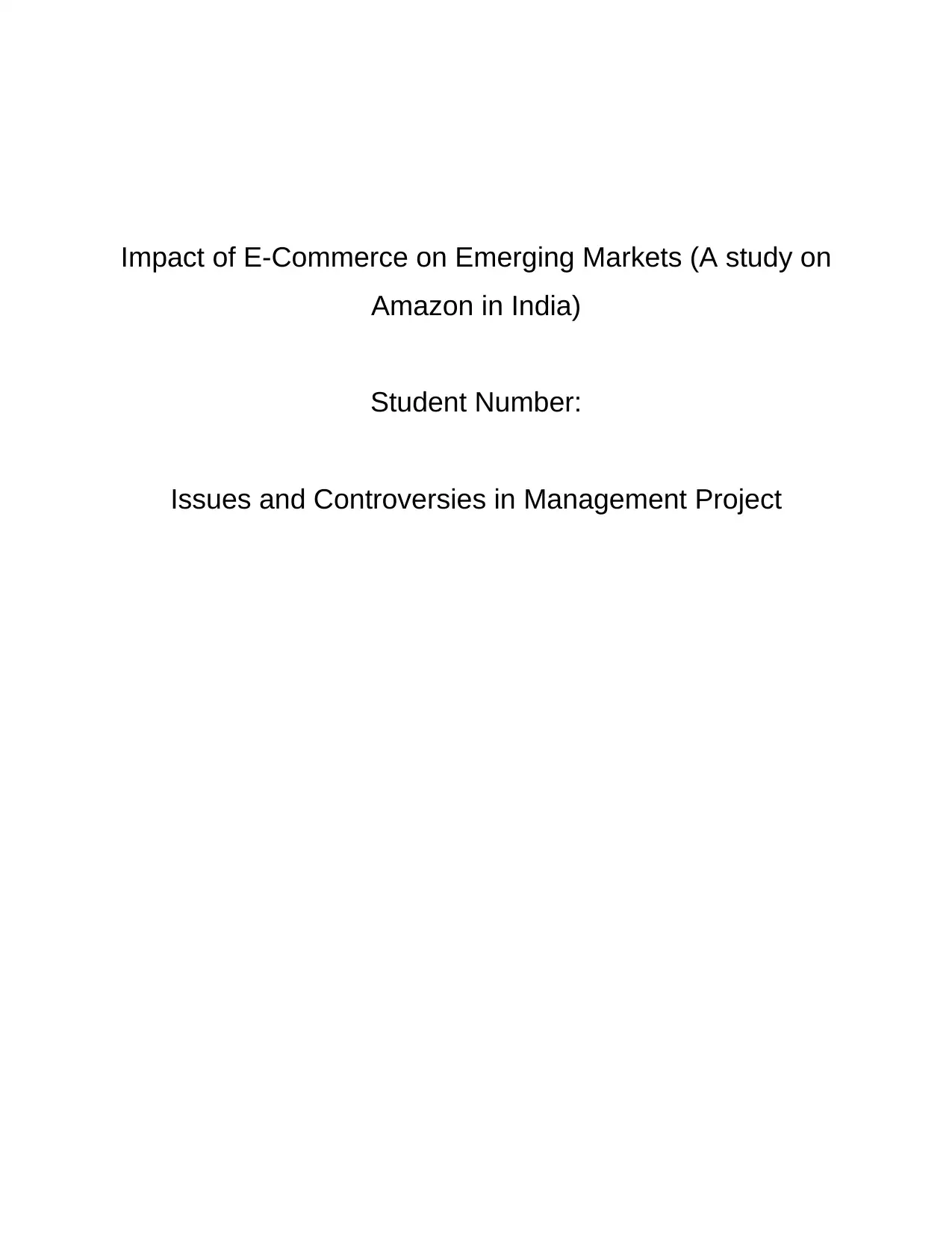
Impact of E-Commerce on Emerging Markets (A study on
Amazon in India)
Student Number:
Issues and Controversies in Management Project
Amazon in India)
Student Number:
Issues and Controversies in Management Project
Paraphrase This Document
Need a fresh take? Get an instant paraphrase of this document with our AI Paraphraser
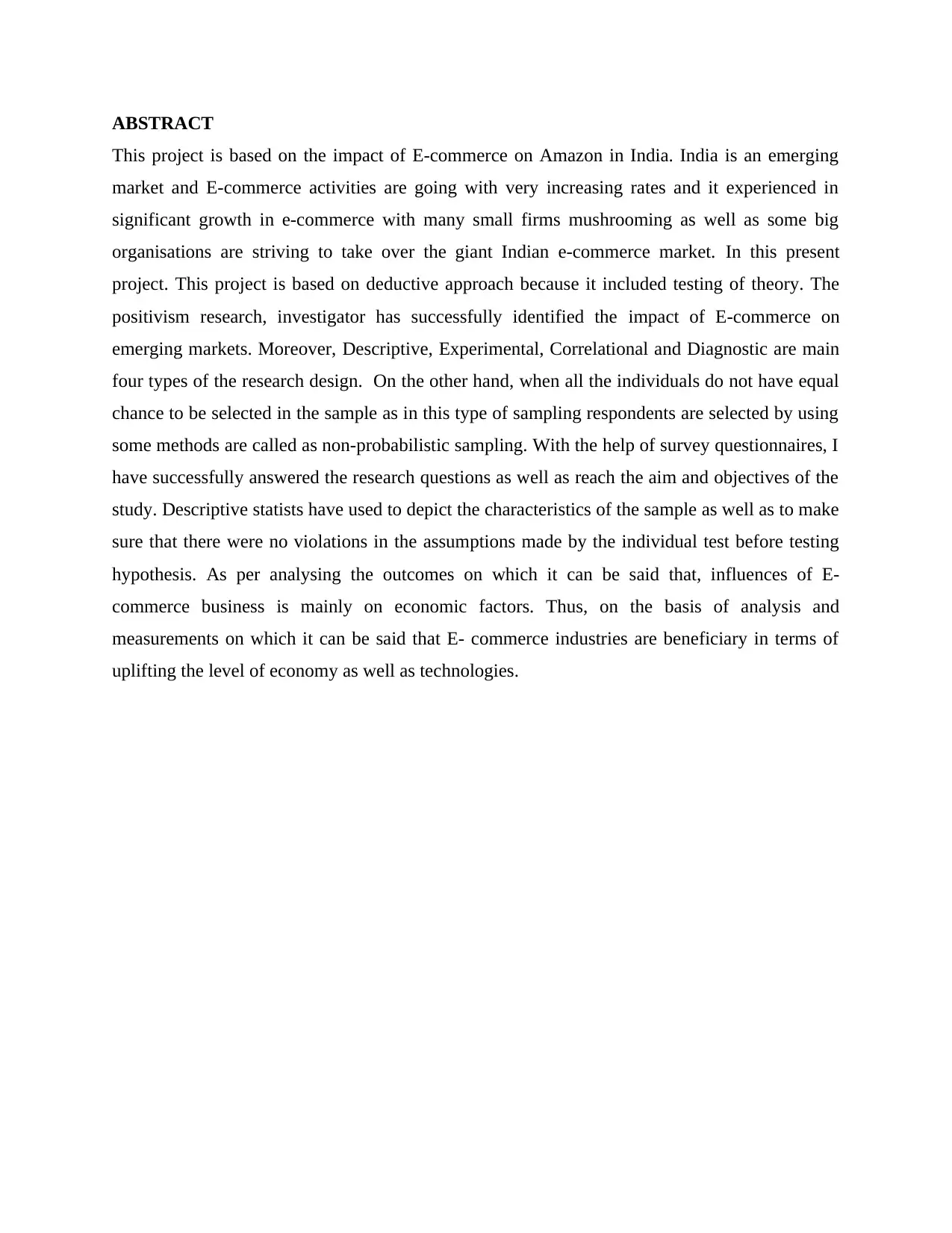
ABSTRACT
This project is based on the impact of E-commerce on Amazon in India. India is an emerging
market and E-commerce activities are going with very increasing rates and it experienced in
significant growth in e-commerce with many small firms mushrooming as well as some big
organisations are striving to take over the giant Indian e-commerce market. In this present
project. This project is based on deductive approach because it included testing of theory. The
positivism research, investigator has successfully identified the impact of E-commerce on
emerging markets. Moreover, Descriptive, Experimental, Correlational and Diagnostic are main
four types of the research design. On the other hand, when all the individuals do not have equal
chance to be selected in the sample as in this type of sampling respondents are selected by using
some methods are called as non-probabilistic sampling. With the help of survey questionnaires, I
have successfully answered the research questions as well as reach the aim and objectives of the
study. Descriptive statists have used to depict the characteristics of the sample as well as to make
sure that there were no violations in the assumptions made by the individual test before testing
hypothesis. As per analysing the outcomes on which it can be said that, influences of E-
commerce business is mainly on economic factors. Thus, on the basis of analysis and
measurements on which it can be said that E- commerce industries are beneficiary in terms of
uplifting the level of economy as well as technologies.
This project is based on the impact of E-commerce on Amazon in India. India is an emerging
market and E-commerce activities are going with very increasing rates and it experienced in
significant growth in e-commerce with many small firms mushrooming as well as some big
organisations are striving to take over the giant Indian e-commerce market. In this present
project. This project is based on deductive approach because it included testing of theory. The
positivism research, investigator has successfully identified the impact of E-commerce on
emerging markets. Moreover, Descriptive, Experimental, Correlational and Diagnostic are main
four types of the research design. On the other hand, when all the individuals do not have equal
chance to be selected in the sample as in this type of sampling respondents are selected by using
some methods are called as non-probabilistic sampling. With the help of survey questionnaires, I
have successfully answered the research questions as well as reach the aim and objectives of the
study. Descriptive statists have used to depict the characteristics of the sample as well as to make
sure that there were no violations in the assumptions made by the individual test before testing
hypothesis. As per analysing the outcomes on which it can be said that, influences of E-
commerce business is mainly on economic factors. Thus, on the basis of analysis and
measurements on which it can be said that E- commerce industries are beneficiary in terms of
uplifting the level of economy as well as technologies.

ACKNOWLEDGMENT
I would like to thank my supervisor for helping me and guiding me through this research. Also, I
am glad to have supportive friends and Family who have encouraged me in implicating efforts
and motivating me for reflecting my learning, skills and talent in this project. Moreover, at last I
would like to thank all the participants who have represented their reviews, opinion and
supported my survey to have better study on the facts.
I would like to thank my supervisor for helping me and guiding me through this research. Also, I
am glad to have supportive friends and Family who have encouraged me in implicating efforts
and motivating me for reflecting my learning, skills and talent in this project. Moreover, at last I
would like to thank all the participants who have represented their reviews, opinion and
supported my survey to have better study on the facts.
⊘ This is a preview!⊘
Do you want full access?
Subscribe today to unlock all pages.

Trusted by 1+ million students worldwide
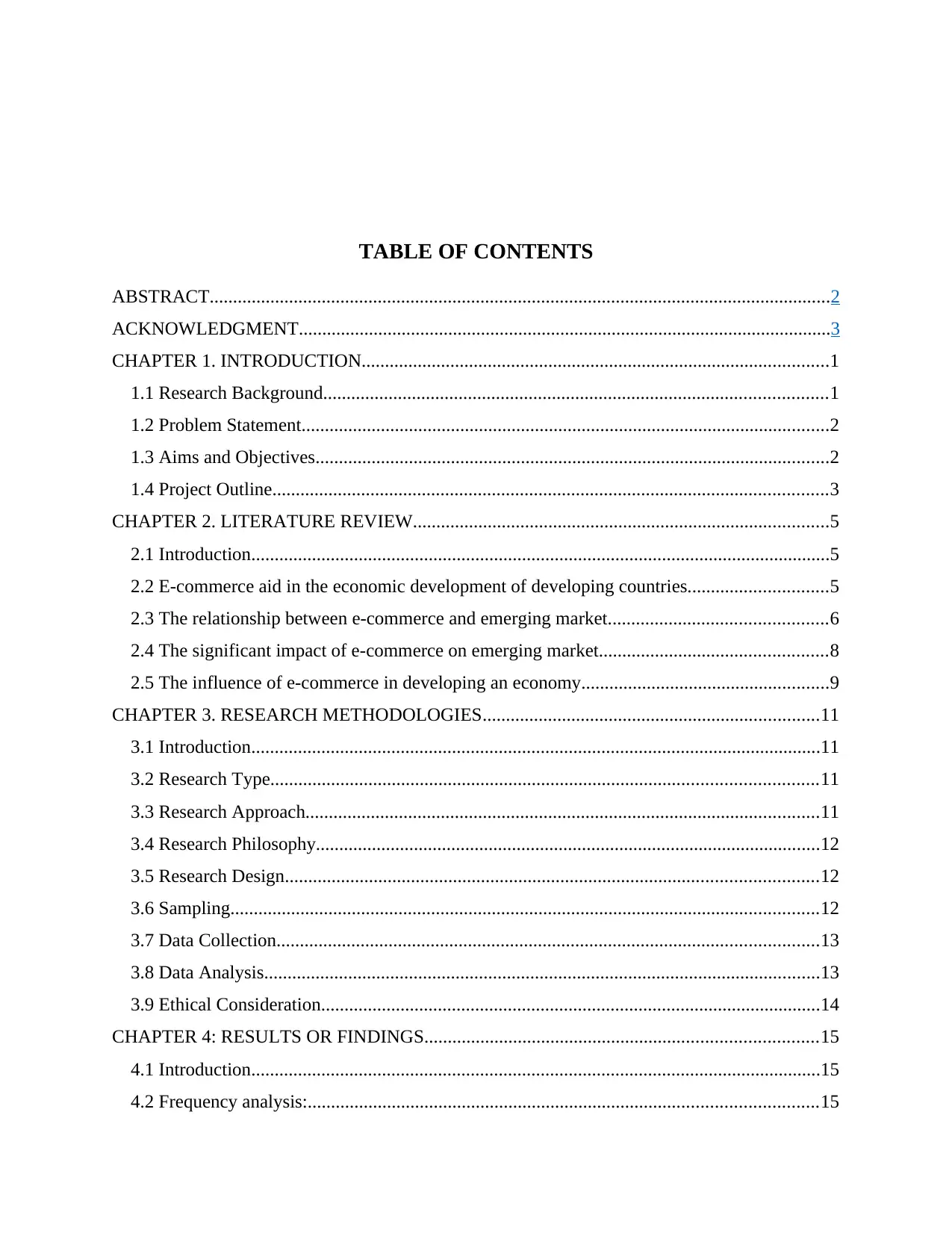
TABLE OF CONTENTS
ABSTRACT.....................................................................................................................................2
ACKNOWLEDGMENT..................................................................................................................3
CHAPTER 1. INTRODUCTION....................................................................................................1
1.1 Research Background............................................................................................................1
1.2 Problem Statement.................................................................................................................2
1.3 Aims and Objectives..............................................................................................................2
1.4 Project Outline.......................................................................................................................3
CHAPTER 2. LITERATURE REVIEW.........................................................................................5
2.1 Introduction............................................................................................................................5
2.2 E-commerce aid in the economic development of developing countries..............................5
2.3 The relationship between e-commerce and emerging market...............................................6
2.4 The significant impact of e-commerce on emerging market.................................................8
2.5 The influence of e-commerce in developing an economy.....................................................9
CHAPTER 3. RESEARCH METHODOLOGIES........................................................................11
3.1 Introduction..........................................................................................................................11
3.2 Research Type.....................................................................................................................11
3.3 Research Approach..............................................................................................................11
3.4 Research Philosophy............................................................................................................12
3.5 Research Design..................................................................................................................12
3.6 Sampling..............................................................................................................................12
3.7 Data Collection....................................................................................................................13
3.8 Data Analysis.......................................................................................................................13
3.9 Ethical Consideration...........................................................................................................14
CHAPTER 4: RESULTS OR FINDINGS....................................................................................15
4.1 Introduction..........................................................................................................................15
4.2 Frequency analysis:.............................................................................................................15
ABSTRACT.....................................................................................................................................2
ACKNOWLEDGMENT..................................................................................................................3
CHAPTER 1. INTRODUCTION....................................................................................................1
1.1 Research Background............................................................................................................1
1.2 Problem Statement.................................................................................................................2
1.3 Aims and Objectives..............................................................................................................2
1.4 Project Outline.......................................................................................................................3
CHAPTER 2. LITERATURE REVIEW.........................................................................................5
2.1 Introduction............................................................................................................................5
2.2 E-commerce aid in the economic development of developing countries..............................5
2.3 The relationship between e-commerce and emerging market...............................................6
2.4 The significant impact of e-commerce on emerging market.................................................8
2.5 The influence of e-commerce in developing an economy.....................................................9
CHAPTER 3. RESEARCH METHODOLOGIES........................................................................11
3.1 Introduction..........................................................................................................................11
3.2 Research Type.....................................................................................................................11
3.3 Research Approach..............................................................................................................11
3.4 Research Philosophy............................................................................................................12
3.5 Research Design..................................................................................................................12
3.6 Sampling..............................................................................................................................12
3.7 Data Collection....................................................................................................................13
3.8 Data Analysis.......................................................................................................................13
3.9 Ethical Consideration...........................................................................................................14
CHAPTER 4: RESULTS OR FINDINGS....................................................................................15
4.1 Introduction..........................................................................................................................15
4.2 Frequency analysis:.............................................................................................................15
Paraphrase This Document
Need a fresh take? Get an instant paraphrase of this document with our AI Paraphraser

4.3 Hypothesis findings.............................................................................................................22
4.4 Summary..............................................................................................................................27
CHAPTER 5: DISCUSSION AND CONCLUSION....................................................................28
5.1 Research overview...............................................................................................................28
5.2 Discussion............................................................................................................................28
5.3 Limitations and Future Research.........................................................................................29
5.4 Recommendations................................................................................................................29
5.5 Conclusion...........................................................................................................................30
REFERENCES..............................................................................................................................31
APPENDIX 1.................................................................................................................................34
APPENDIX 2.................................................................................................................................35
APPENDIX 3.................................................................................................................................39
APPENDIX 4.................................................................................................................................41
APPENDEX 1 ..............................................................................................................................34
APPENDEX 2 ..............................................................................................................................35
APPENDEX 3...............................................................................................................................39
APPENDEX 4 ..............................................................................................................................41
4.4 Summary..............................................................................................................................27
CHAPTER 5: DISCUSSION AND CONCLUSION....................................................................28
5.1 Research overview...............................................................................................................28
5.2 Discussion............................................................................................................................28
5.3 Limitations and Future Research.........................................................................................29
5.4 Recommendations................................................................................................................29
5.5 Conclusion...........................................................................................................................30
REFERENCES..............................................................................................................................31
APPENDIX 1.................................................................................................................................34
APPENDIX 2.................................................................................................................................35
APPENDIX 3.................................................................................................................................39
APPENDIX 4.................................................................................................................................41
APPENDEX 1 ..............................................................................................................................34
APPENDEX 2 ..............................................................................................................................35
APPENDEX 3...............................................................................................................................39
APPENDEX 4 ..............................................................................................................................41

CHAPTER 1. INTRODUCTION
In today's era, E-commerce has acquired a great importance in the world. E-commerce is
the commercial transaction conducted electronically on the internet. It is the buying and selling
of goods and services or transmitting data or funds, over an electronic network, primarily the
internet. India's rapid growth across a range of frontiers appears to be good news for global
consumer businesses seeking to access its markets. Internet proliferation and increasing uses of
online shopping channels pose a new opportunity to reach customers. There are various
advantages of E-commerce for the businesses (Leong and et.al., 2016). It makes the process of
buying and selling faster and it also persuades 24/7 availability of goods and services to the
customers. Businesses can reach to the wide range of customers by using internet marketing.
The cost of operation will also minimise by using e-commerce activities. For the business
operating in emerging market, e-commerce facilitates cost effective operations. On the other
hand, the benefits of E-commerce is not limited up to the businesses only, as it is also very
beneficial for the developing countries. It improves the technological sector of the nations, it
generates employment opportunities, encouraging real-estate, generating opportunities for
merchant partners and many others advantages which is very important for the developing
market to develop and grow more.
This chapter provides background information on the impact as well as importance of E-
commerce on emerging markets in developing countries. Amazon company is being chosen for
the study and India is being chosen as emerging market. This chapter will be start with the
research background, problem statement and aims & objectives.
1.1 Research Background
The research study is based on the impact of E-commerce on emerging market. India is
an emerging market and E-commerce activities are increasing with very increasing rates and it
experienced in significant growth in e-commerce with many small firms mushrooming as well as
some big organisations are striving to take over the giant Indian e-commerce market. The
research study will examine the impact of E-commerce on Amazon that is growing its business
in India (Agwu and Murray, 2015). Amazon is a multinational technology company focusing in
e-commerce, artificial intelligence and cloud computing.It is founded by Jeff Bezos in 1994. It is
one of the Four Horsemen of technology along with Google, Apple and Facebook due to its
brand equity, disruptive innovation, market capitalisation and the process of hyper competitive
1
In today's era, E-commerce has acquired a great importance in the world. E-commerce is
the commercial transaction conducted electronically on the internet. It is the buying and selling
of goods and services or transmitting data or funds, over an electronic network, primarily the
internet. India's rapid growth across a range of frontiers appears to be good news for global
consumer businesses seeking to access its markets. Internet proliferation and increasing uses of
online shopping channels pose a new opportunity to reach customers. There are various
advantages of E-commerce for the businesses (Leong and et.al., 2016). It makes the process of
buying and selling faster and it also persuades 24/7 availability of goods and services to the
customers. Businesses can reach to the wide range of customers by using internet marketing.
The cost of operation will also minimise by using e-commerce activities. For the business
operating in emerging market, e-commerce facilitates cost effective operations. On the other
hand, the benefits of E-commerce is not limited up to the businesses only, as it is also very
beneficial for the developing countries. It improves the technological sector of the nations, it
generates employment opportunities, encouraging real-estate, generating opportunities for
merchant partners and many others advantages which is very important for the developing
market to develop and grow more.
This chapter provides background information on the impact as well as importance of E-
commerce on emerging markets in developing countries. Amazon company is being chosen for
the study and India is being chosen as emerging market. This chapter will be start with the
research background, problem statement and aims & objectives.
1.1 Research Background
The research study is based on the impact of E-commerce on emerging market. India is
an emerging market and E-commerce activities are increasing with very increasing rates and it
experienced in significant growth in e-commerce with many small firms mushrooming as well as
some big organisations are striving to take over the giant Indian e-commerce market. The
research study will examine the impact of E-commerce on Amazon that is growing its business
in India (Agwu and Murray, 2015). Amazon is a multinational technology company focusing in
e-commerce, artificial intelligence and cloud computing.It is founded by Jeff Bezos in 1994. It is
one of the Four Horsemen of technology along with Google, Apple and Facebook due to its
brand equity, disruptive innovation, market capitalisation and the process of hyper competitive
1
⊘ This is a preview!⊘
Do you want full access?
Subscribe today to unlock all pages.

Trusted by 1+ million students worldwide
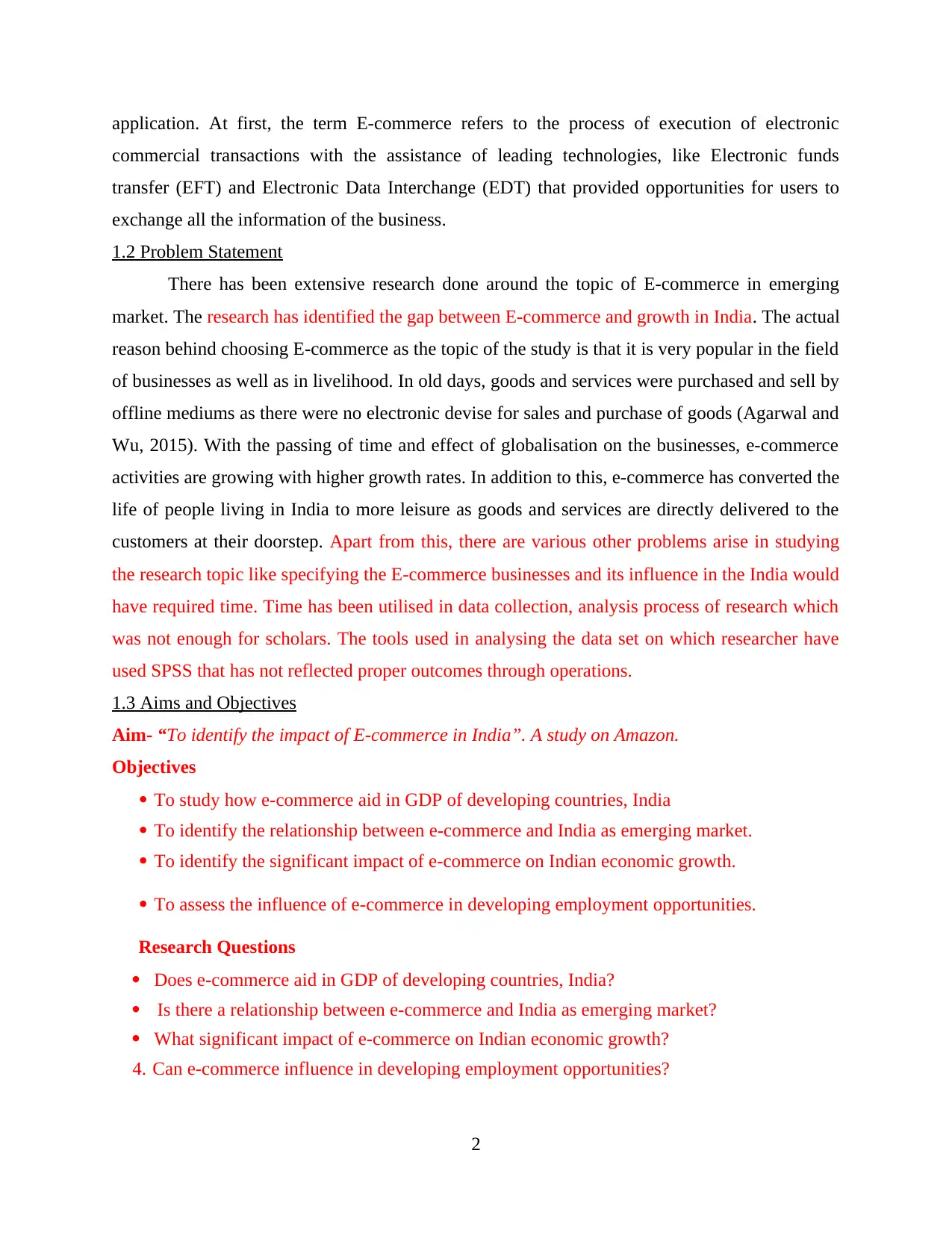
application. At first, the term E-commerce refers to the process of execution of electronic
commercial transactions with the assistance of leading technologies, like Electronic funds
transfer (EFT) and Electronic Data Interchange (EDT) that provided opportunities for users to
exchange all the information of the business.
1.2 Problem Statement
There has been extensive research done around the topic of E-commerce in emerging
market. The research has identified the gap between E-commerce and growth in India. The actual
reason behind choosing E-commerce as the topic of the study is that it is very popular in the field
of businesses as well as in livelihood. In old days, goods and services were purchased and sell by
offline mediums as there were no electronic devise for sales and purchase of goods (Agarwal and
Wu, 2015). With the passing of time and effect of globalisation on the businesses, e-commerce
activities are growing with higher growth rates. In addition to this, e-commerce has converted the
life of people living in India to more leisure as goods and services are directly delivered to the
customers at their doorstep. Apart from this, there are various other problems arise in studying
the research topic like specifying the E-commerce businesses and its influence in the India would
have required time. Time has been utilised in data collection, analysis process of research which
was not enough for scholars. The tools used in analysing the data set on which researcher have
used SPSS that has not reflected proper outcomes through operations.
1.3 Aims and Objectives
Aim- “To identify the impact of E-commerce in India”. A study on Amazon.
Objectives
To study how e-commerce aid in GDP of developing countries, India
To identify the relationship between e-commerce and India as emerging market.
To identify the significant impact of e-commerce on Indian economic growth.
To assess the influence of e-commerce in developing employment opportunities.
Research Questions
Does e-commerce aid in GDP of developing countries, India?
Is there a relationship between e-commerce and India as emerging market?
What significant impact of e-commerce on Indian economic growth?
4. Can e-commerce influence in developing employment opportunities?
2
commercial transactions with the assistance of leading technologies, like Electronic funds
transfer (EFT) and Electronic Data Interchange (EDT) that provided opportunities for users to
exchange all the information of the business.
1.2 Problem Statement
There has been extensive research done around the topic of E-commerce in emerging
market. The research has identified the gap between E-commerce and growth in India. The actual
reason behind choosing E-commerce as the topic of the study is that it is very popular in the field
of businesses as well as in livelihood. In old days, goods and services were purchased and sell by
offline mediums as there were no electronic devise for sales and purchase of goods (Agarwal and
Wu, 2015). With the passing of time and effect of globalisation on the businesses, e-commerce
activities are growing with higher growth rates. In addition to this, e-commerce has converted the
life of people living in India to more leisure as goods and services are directly delivered to the
customers at their doorstep. Apart from this, there are various other problems arise in studying
the research topic like specifying the E-commerce businesses and its influence in the India would
have required time. Time has been utilised in data collection, analysis process of research which
was not enough for scholars. The tools used in analysing the data set on which researcher have
used SPSS that has not reflected proper outcomes through operations.
1.3 Aims and Objectives
Aim- “To identify the impact of E-commerce in India”. A study on Amazon.
Objectives
To study how e-commerce aid in GDP of developing countries, India
To identify the relationship between e-commerce and India as emerging market.
To identify the significant impact of e-commerce on Indian economic growth.
To assess the influence of e-commerce in developing employment opportunities.
Research Questions
Does e-commerce aid in GDP of developing countries, India?
Is there a relationship between e-commerce and India as emerging market?
What significant impact of e-commerce on Indian economic growth?
4. Can e-commerce influence in developing employment opportunities?
2
Paraphrase This Document
Need a fresh take? Get an instant paraphrase of this document with our AI Paraphraser

1.4 Project Outline
Chapter 1. Introduction This chapter outlines the
summary of the topic on which
research study is based on. In
this present study, scholar will
focus on brief understanding of
topic of the investigation.
Further, the research
background will also provide
in this chapter where the
reason of choosing the topic
(impact of E-commerce on
emerging markets) will be
explained. Aims and on the
basis of aim, objectives are
form and on the basis of
objectives will be prepared.
Chapter 2. Literature Review In this project the second
chapter where the discussion
of secondary facts along with
finding from various authentic
sources will be studied. On the
basis of information collected,
i have will identify the actual
impact of e-commerce on
businesses in emerging market.
Theoretical framework was
introduces along with research
hypothesis will also be
developed in this chapter.
3
Chapter 1. Introduction This chapter outlines the
summary of the topic on which
research study is based on. In
this present study, scholar will
focus on brief understanding of
topic of the investigation.
Further, the research
background will also provide
in this chapter where the
reason of choosing the topic
(impact of E-commerce on
emerging markets) will be
explained. Aims and on the
basis of aim, objectives are
form and on the basis of
objectives will be prepared.
Chapter 2. Literature Review In this project the second
chapter where the discussion
of secondary facts along with
finding from various authentic
sources will be studied. On the
basis of information collected,
i have will identify the actual
impact of e-commerce on
businesses in emerging market.
Theoretical framework was
introduces along with research
hypothesis will also be
developed in this chapter.
3
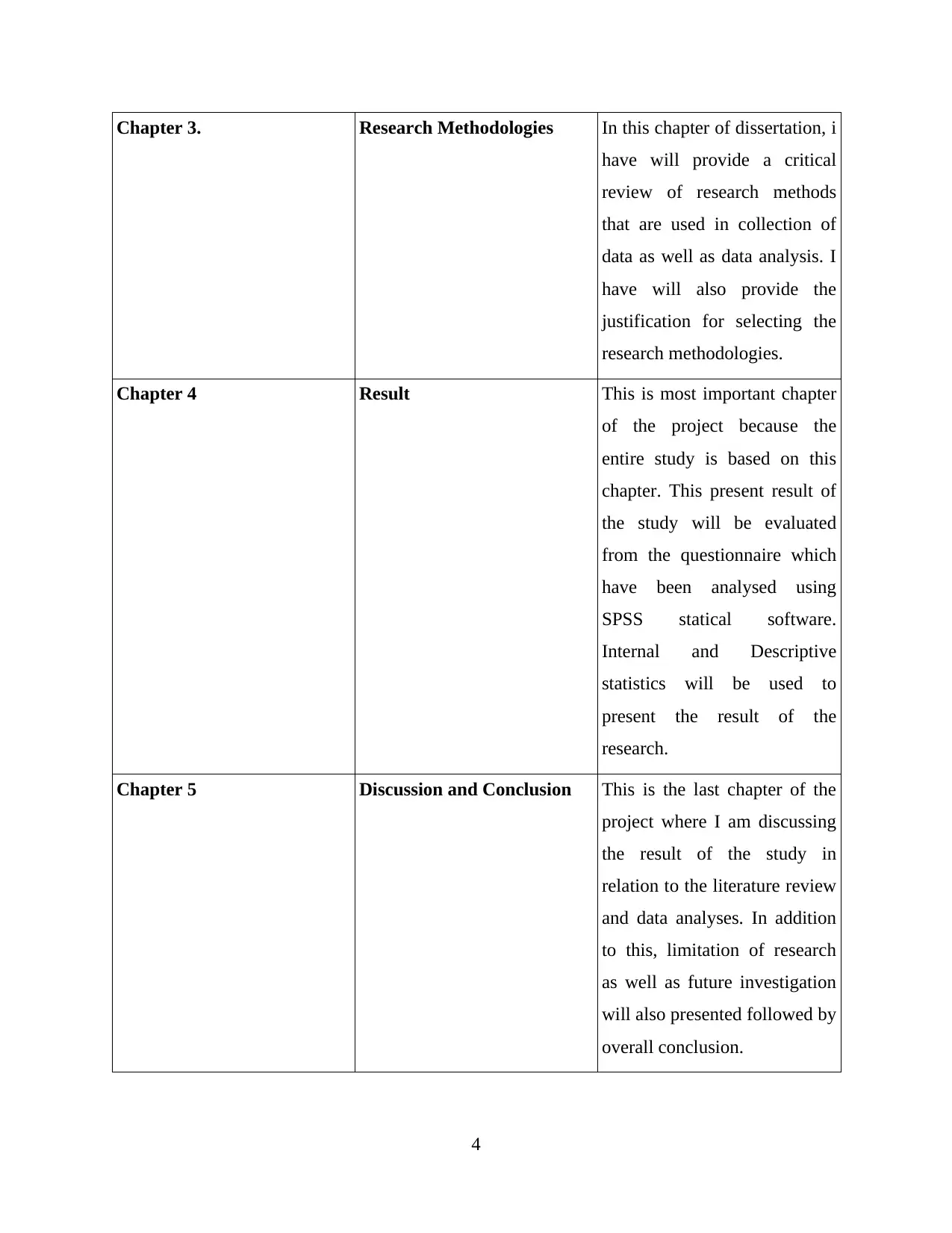
Chapter 3. Research Methodologies In this chapter of dissertation, i
have will provide a critical
review of research methods
that are used in collection of
data as well as data analysis. I
have will also provide the
justification for selecting the
research methodologies.
Chapter 4 Result This is most important chapter
of the project because the
entire study is based on this
chapter. This present result of
the study will be evaluated
from the questionnaire which
have been analysed using
SPSS statical software.
Internal and Descriptive
statistics will be used to
present the result of the
research.
Chapter 5 Discussion and Conclusion This is the last chapter of the
project where I am discussing
the result of the study in
relation to the literature review
and data analyses. In addition
to this, limitation of research
as well as future investigation
will also presented followed by
overall conclusion.
4
have will provide a critical
review of research methods
that are used in collection of
data as well as data analysis. I
have will also provide the
justification for selecting the
research methodologies.
Chapter 4 Result This is most important chapter
of the project because the
entire study is based on this
chapter. This present result of
the study will be evaluated
from the questionnaire which
have been analysed using
SPSS statical software.
Internal and Descriptive
statistics will be used to
present the result of the
research.
Chapter 5 Discussion and Conclusion This is the last chapter of the
project where I am discussing
the result of the study in
relation to the literature review
and data analyses. In addition
to this, limitation of research
as well as future investigation
will also presented followed by
overall conclusion.
4
⊘ This is a preview!⊘
Do you want full access?
Subscribe today to unlock all pages.

Trusted by 1+ million students worldwide
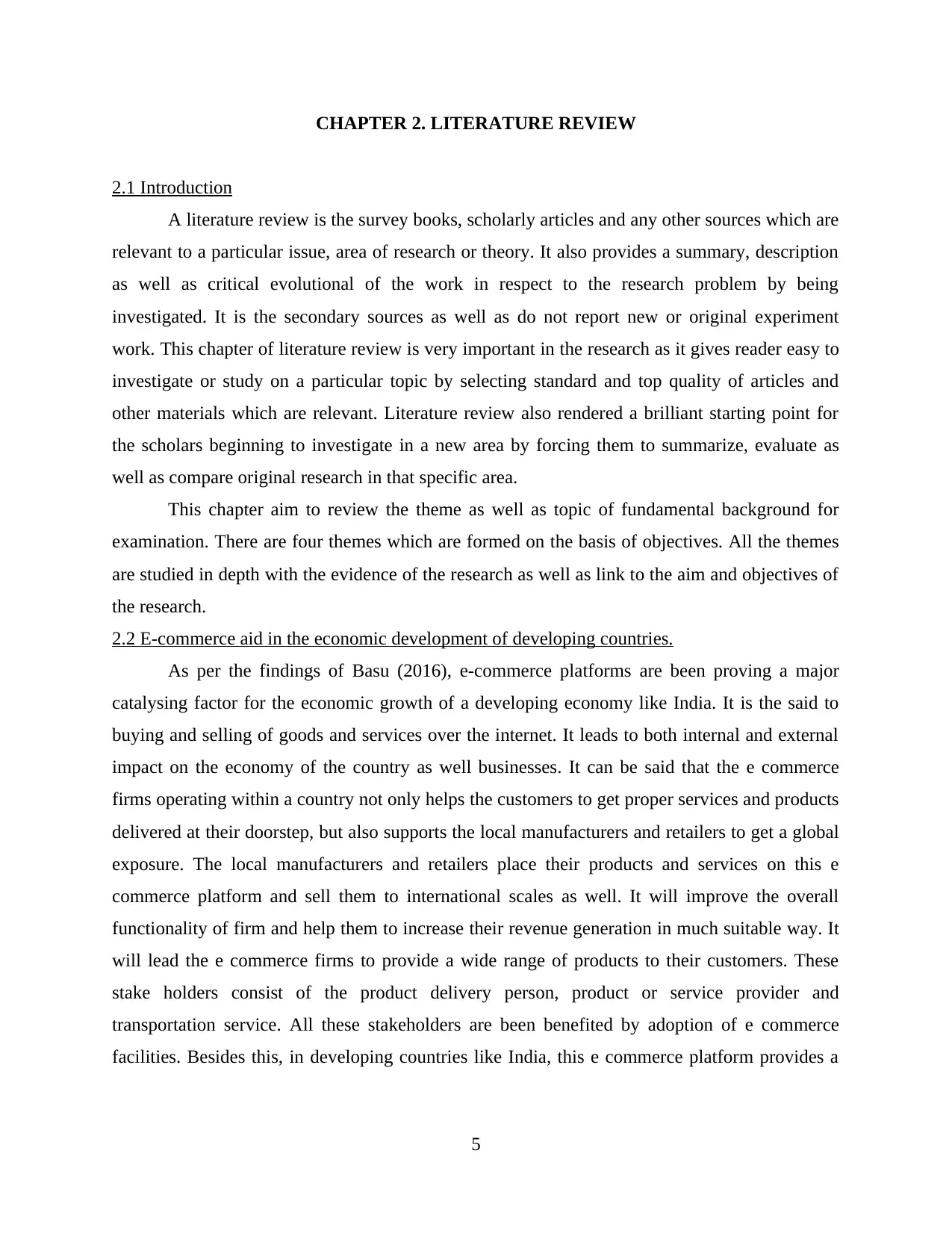
CHAPTER 2. LITERATURE REVIEW
2.1 Introduction
A literature review is the survey books, scholarly articles and any other sources which are
relevant to a particular issue, area of research or theory. It also provides a summary, description
as well as critical evolutional of the work in respect to the research problem by being
investigated. It is the secondary sources as well as do not report new or original experiment
work. This chapter of literature review is very important in the research as it gives reader easy to
investigate or study on a particular topic by selecting standard and top quality of articles and
other materials which are relevant. Literature review also rendered a brilliant starting point for
the scholars beginning to investigate in a new area by forcing them to summarize, evaluate as
well as compare original research in that specific area.
This chapter aim to review the theme as well as topic of fundamental background for
examination. There are four themes which are formed on the basis of objectives. All the themes
are studied in depth with the evidence of the research as well as link to the aim and objectives of
the research.
2.2 E-commerce aid in the economic development of developing countries.
As per the findings of Basu (2016), e-commerce platforms are been proving a major
catalysing factor for the economic growth of a developing economy like India. It is the said to
buying and selling of goods and services over the internet. It leads to both internal and external
impact on the economy of the country as well businesses. It can be said that the e commerce
firms operating within a country not only helps the customers to get proper services and products
delivered at their doorstep, but also supports the local manufacturers and retailers to get a global
exposure. The local manufacturers and retailers place their products and services on this e
commerce platform and sell them to international scales as well. It will improve the overall
functionality of firm and help them to increase their revenue generation in much suitable way. It
will lead the e commerce firms to provide a wide range of products to their customers. These
stake holders consist of the product delivery person, product or service provider and
transportation service. All these stakeholders are been benefited by adoption of e commerce
facilities. Besides this, in developing countries like India, this e commerce platform provides a
5
2.1 Introduction
A literature review is the survey books, scholarly articles and any other sources which are
relevant to a particular issue, area of research or theory. It also provides a summary, description
as well as critical evolutional of the work in respect to the research problem by being
investigated. It is the secondary sources as well as do not report new or original experiment
work. This chapter of literature review is very important in the research as it gives reader easy to
investigate or study on a particular topic by selecting standard and top quality of articles and
other materials which are relevant. Literature review also rendered a brilliant starting point for
the scholars beginning to investigate in a new area by forcing them to summarize, evaluate as
well as compare original research in that specific area.
This chapter aim to review the theme as well as topic of fundamental background for
examination. There are four themes which are formed on the basis of objectives. All the themes
are studied in depth with the evidence of the research as well as link to the aim and objectives of
the research.
2.2 E-commerce aid in the economic development of developing countries.
As per the findings of Basu (2016), e-commerce platforms are been proving a major
catalysing factor for the economic growth of a developing economy like India. It is the said to
buying and selling of goods and services over the internet. It leads to both internal and external
impact on the economy of the country as well businesses. It can be said that the e commerce
firms operating within a country not only helps the customers to get proper services and products
delivered at their doorstep, but also supports the local manufacturers and retailers to get a global
exposure. The local manufacturers and retailers place their products and services on this e
commerce platform and sell them to international scales as well. It will improve the overall
functionality of firm and help them to increase their revenue generation in much suitable way. It
will lead the e commerce firms to provide a wide range of products to their customers. These
stake holders consist of the product delivery person, product or service provider and
transportation service. All these stakeholders are been benefited by adoption of e commerce
facilities. Besides this, in developing countries like India, this e commerce platform provides a
5
Paraphrase This Document
Need a fresh take? Get an instant paraphrase of this document with our AI Paraphraser
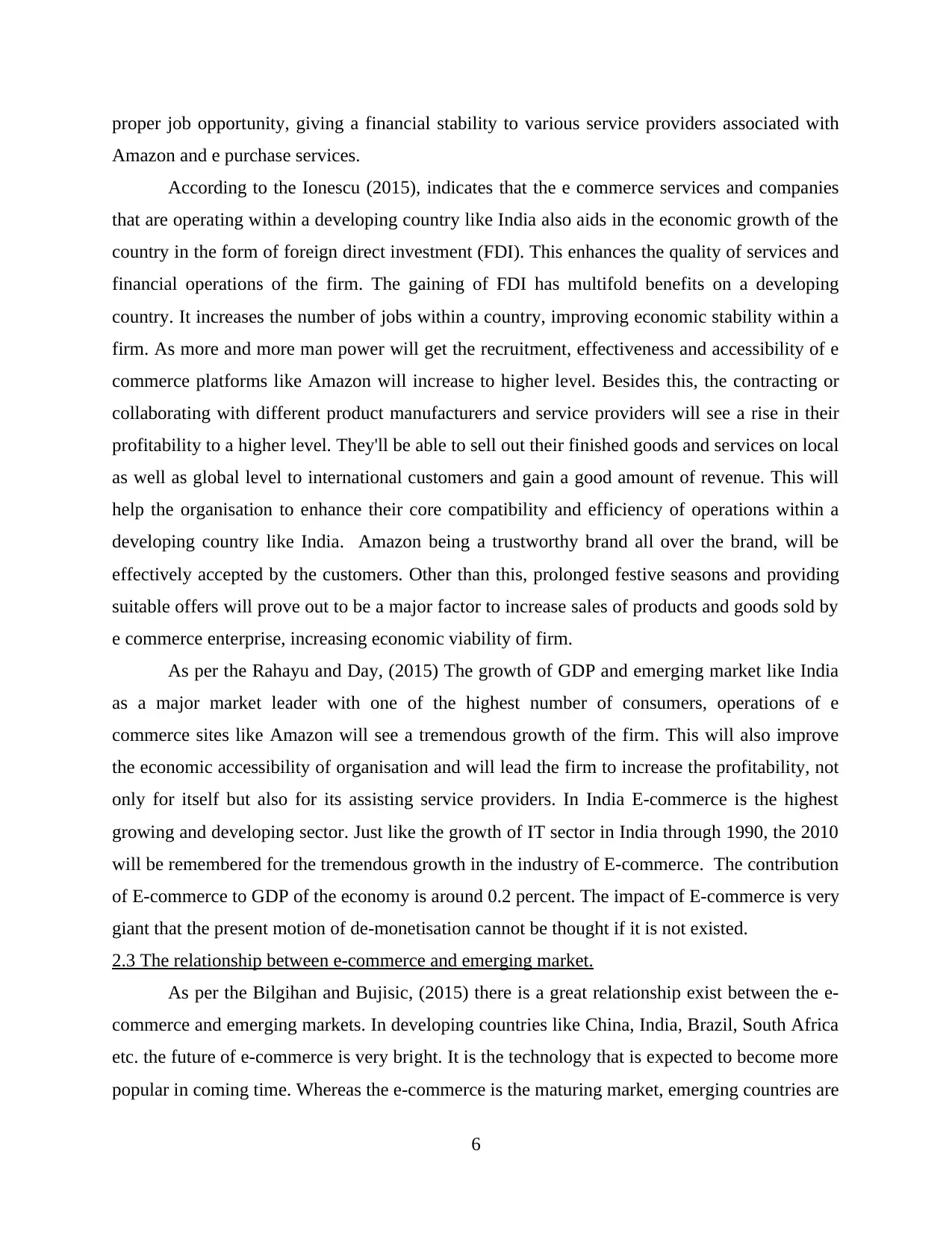
proper job opportunity, giving a financial stability to various service providers associated with
Amazon and e purchase services.
According to the Ionescu (2015), indicates that the e commerce services and companies
that are operating within a developing country like India also aids in the economic growth of the
country in the form of foreign direct investment (FDI). This enhances the quality of services and
financial operations of the firm. The gaining of FDI has multifold benefits on a developing
country. It increases the number of jobs within a country, improving economic stability within a
firm. As more and more man power will get the recruitment, effectiveness and accessibility of e
commerce platforms like Amazon will increase to higher level. Besides this, the contracting or
collaborating with different product manufacturers and service providers will see a rise in their
profitability to a higher level. They'll be able to sell out their finished goods and services on local
as well as global level to international customers and gain a good amount of revenue. This will
help the organisation to enhance their core compatibility and efficiency of operations within a
developing country like India. Amazon being a trustworthy brand all over the brand, will be
effectively accepted by the customers. Other than this, prolonged festive seasons and providing
suitable offers will prove out to be a major factor to increase sales of products and goods sold by
e commerce enterprise, increasing economic viability of firm.
As per the Rahayu and Day, (2015) The growth of GDP and emerging market like India
as a major market leader with one of the highest number of consumers, operations of e
commerce sites like Amazon will see a tremendous growth of the firm. This will also improve
the economic accessibility of organisation and will lead the firm to increase the profitability, not
only for itself but also for its assisting service providers. In India E-commerce is the highest
growing and developing sector. Just like the growth of IT sector in India through 1990, the 2010
will be remembered for the tremendous growth in the industry of E-commerce. The contribution
of E-commerce to GDP of the economy is around 0.2 percent. The impact of E-commerce is very
giant that the present motion of de-monetisation cannot be thought if it is not existed.
2.3 The relationship between e-commerce and emerging market.
As per the Bilgihan and Bujisic, (2015) there is a great relationship exist between the e-
commerce and emerging markets. In developing countries like China, India, Brazil, South Africa
etc. the future of e-commerce is very bright. It is the technology that is expected to become more
popular in coming time. Whereas the e-commerce is the maturing market, emerging countries are
6
Amazon and e purchase services.
According to the Ionescu (2015), indicates that the e commerce services and companies
that are operating within a developing country like India also aids in the economic growth of the
country in the form of foreign direct investment (FDI). This enhances the quality of services and
financial operations of the firm. The gaining of FDI has multifold benefits on a developing
country. It increases the number of jobs within a country, improving economic stability within a
firm. As more and more man power will get the recruitment, effectiveness and accessibility of e
commerce platforms like Amazon will increase to higher level. Besides this, the contracting or
collaborating with different product manufacturers and service providers will see a rise in their
profitability to a higher level. They'll be able to sell out their finished goods and services on local
as well as global level to international customers and gain a good amount of revenue. This will
help the organisation to enhance their core compatibility and efficiency of operations within a
developing country like India. Amazon being a trustworthy brand all over the brand, will be
effectively accepted by the customers. Other than this, prolonged festive seasons and providing
suitable offers will prove out to be a major factor to increase sales of products and goods sold by
e commerce enterprise, increasing economic viability of firm.
As per the Rahayu and Day, (2015) The growth of GDP and emerging market like India
as a major market leader with one of the highest number of consumers, operations of e
commerce sites like Amazon will see a tremendous growth of the firm. This will also improve
the economic accessibility of organisation and will lead the firm to increase the profitability, not
only for itself but also for its assisting service providers. In India E-commerce is the highest
growing and developing sector. Just like the growth of IT sector in India through 1990, the 2010
will be remembered for the tremendous growth in the industry of E-commerce. The contribution
of E-commerce to GDP of the economy is around 0.2 percent. The impact of E-commerce is very
giant that the present motion of de-monetisation cannot be thought if it is not existed.
2.3 The relationship between e-commerce and emerging market.
As per the Bilgihan and Bujisic, (2015) there is a great relationship exist between the e-
commerce and emerging markets. In developing countries like China, India, Brazil, South Africa
etc. the future of e-commerce is very bright. It is the technology that is expected to become more
popular in coming time. Whereas the e-commerce is the maturing market, emerging countries are
6

balanced to become the succeeding mega market as the acceptance of internet raises bit-by-bit.
All over the regions, emerging markets are the hotbeds for e-commerce which comes with
specific opportunities as well as challenges. In emerging or developing, e-commerce is
flourishing exponentially. There is direct relationship between the e-commerce and emerging
market as high use of e-commerce activities means high growth and development of the country.
As the findings of Rust and Kannan, (2016) the future of e-commerce in emerging market
like India is very strong. There are some industries where the growth of e-commerce is very high
such as in retail, logistic, manufacturing, supply chains, online businesses etc. It is fact that in
India, there will be large share of population who will buy goods via online medium by 2025
which is not so far from the average penetration of 65% of developed nations. The total annual
online retail sales across emerging markets such as Brazil, India, Indonesia could be reach up to
3.7 trillion as well as influenced the organisations across dynamic industries such as
manufacturing, retail, finance, technology and security.
According to the Shaikh and Karjaluoto, (2015) In India, the way of conducting
businesses is changes with the emergence of e-commerce. With the use of mobile phones and
smartphones or adoption of e-commerce, the growth of economy is on highest peak which shows
the interconnection or relationship between the e-commerce and emerging markets. If emerging
countries adopt e-commerce, then it will increase the GDP of the developing nations. With the
help of E-commerce, emerging markets can easily make an effective connection with the
developed nations which is great opportunities for them to grow and develop more. Smartphones
are the core driver for the online access. There are various benefits that e-commerce has on the
growth and development of emerging market like with the use on latest technologies, the process
of buying and selling becomes very fast and convenient.
The speedy elaboration of e-commerce is transforming many emerging nations, bringing
an array of advantages for the customers as well as entrepreneurs as said by Rust and Kannan,
(2016). Whereas, there are distinct opportunities for dynamic huge, local business can hold
unique advantage. In emerging market, the increase of e-commerce brings many advantages to
the customers specially people living or operating businesses in remote or rural areas. The
emergence or rise of e-commerce help to develop countries by bringing more affectivity in the
system as well as it also attracts innovative products. In addition to this, the relationship between
7
All over the regions, emerging markets are the hotbeds for e-commerce which comes with
specific opportunities as well as challenges. In emerging or developing, e-commerce is
flourishing exponentially. There is direct relationship between the e-commerce and emerging
market as high use of e-commerce activities means high growth and development of the country.
As the findings of Rust and Kannan, (2016) the future of e-commerce in emerging market
like India is very strong. There are some industries where the growth of e-commerce is very high
such as in retail, logistic, manufacturing, supply chains, online businesses etc. It is fact that in
India, there will be large share of population who will buy goods via online medium by 2025
which is not so far from the average penetration of 65% of developed nations. The total annual
online retail sales across emerging markets such as Brazil, India, Indonesia could be reach up to
3.7 trillion as well as influenced the organisations across dynamic industries such as
manufacturing, retail, finance, technology and security.
According to the Shaikh and Karjaluoto, (2015) In India, the way of conducting
businesses is changes with the emergence of e-commerce. With the use of mobile phones and
smartphones or adoption of e-commerce, the growth of economy is on highest peak which shows
the interconnection or relationship between the e-commerce and emerging markets. If emerging
countries adopt e-commerce, then it will increase the GDP of the developing nations. With the
help of E-commerce, emerging markets can easily make an effective connection with the
developed nations which is great opportunities for them to grow and develop more. Smartphones
are the core driver for the online access. There are various benefits that e-commerce has on the
growth and development of emerging market like with the use on latest technologies, the process
of buying and selling becomes very fast and convenient.
The speedy elaboration of e-commerce is transforming many emerging nations, bringing
an array of advantages for the customers as well as entrepreneurs as said by Rust and Kannan,
(2016). Whereas, there are distinct opportunities for dynamic huge, local business can hold
unique advantage. In emerging market, the increase of e-commerce brings many advantages to
the customers specially people living or operating businesses in remote or rural areas. The
emergence or rise of e-commerce help to develop countries by bringing more affectivity in the
system as well as it also attracts innovative products. In addition to this, the relationship between
7
⊘ This is a preview!⊘
Do you want full access?
Subscribe today to unlock all pages.

Trusted by 1+ million students worldwide
1 out of 46
Related Documents
Your All-in-One AI-Powered Toolkit for Academic Success.
+13062052269
info@desklib.com
Available 24*7 on WhatsApp / Email
![[object Object]](/_next/static/media/star-bottom.7253800d.svg)
Unlock your academic potential
Copyright © 2020–2025 A2Z Services. All Rights Reserved. Developed and managed by ZUCOL.





